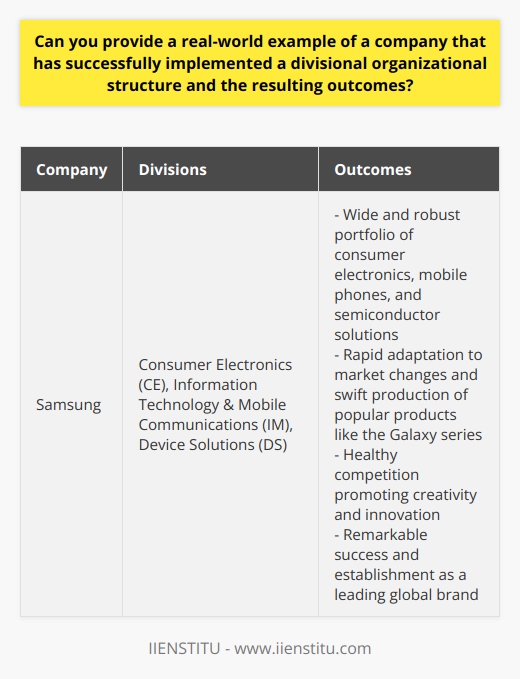
Definition of Divisional Structure
Benefits of Divisional Structure
Challenges of Divisional Structure
Companies are facing ever-increasing competition, and it is becoming increasingly important for corporations to differentiate themselves and their products to succeed. One way in which companies can do this is through the implementation of a divisional structure. This type of organizational structure divides the company into smaller units or “divisions” that specialize in one area. Each division is autonomous, allowing for increased focus and efficiency for working on niche projects. In this blog post, we will examine the concept of divisional structure and its benefits and challenges for a corporation.
Definition of Divisional Structure
Divisional structure is an organizational structure wherein each division operates separately. This can be used with the traditional hierarchical structure, depending on the company’s needs. Divisions can be formed by product lines, markets, customers, or geographical locations. Each division will have its own goals, strategies, and budgets. The idea behind dividing the company into smaller sub-divisions is that it allows for increased focus and specialization. It also allows for increased innovation and will enable departments to work more closely with one another.
Benefits of Divisional Structure
The divisional structure allows corporations to benefit from improved efficiency and manageability. By having divisions dedicated to specific areas, companies can streamline their resources and ensure everyone is operating towards the same goals. This increased focus also increases efficiency, as tasks are done more quickly and with less wasted effort. Additionally, corporations benefit from improved manageability, as the divisional structure allows for better decision-making due to improved communication and clarity of goals.
Challenges of Divisional Structure
Despite the benefits of some challenges in a divisional structure, some challenges come with them. One of the most significant issues with this type of organizational structure is that it can lead to complex decision-making processes due to the increased number of stakeholders involved. In addition, as each division is operating as its entity, decisions have to pass through multiple levels of approval before they can be put into action. This can cause delays in implementation and can lead to increased costs. Additionally, the performance of a divisional structure can be expensive, especially when it comes to retraining staff and implementing new systems.
Conclusion: Divisional structure can be an excellent way for corporations to increase their efficiency and manageability and focus on niche areas of their business. By dividing the company into smaller divisions, each specializing in one place, corporations can benefit from increased communication and clarity of goals. However, this type of organizational structure can also lead to more complex decision-making processes and higher Start-up costs. In conclusion, while there are some challenges, the potential benefits of a divisional structure may outweigh the long-term costs. It can be an excellent way for companies to differentiate themselves in the marketplace and unlock new niches.
Dividing up a market may create more opportunities for a business to succeed than competing.
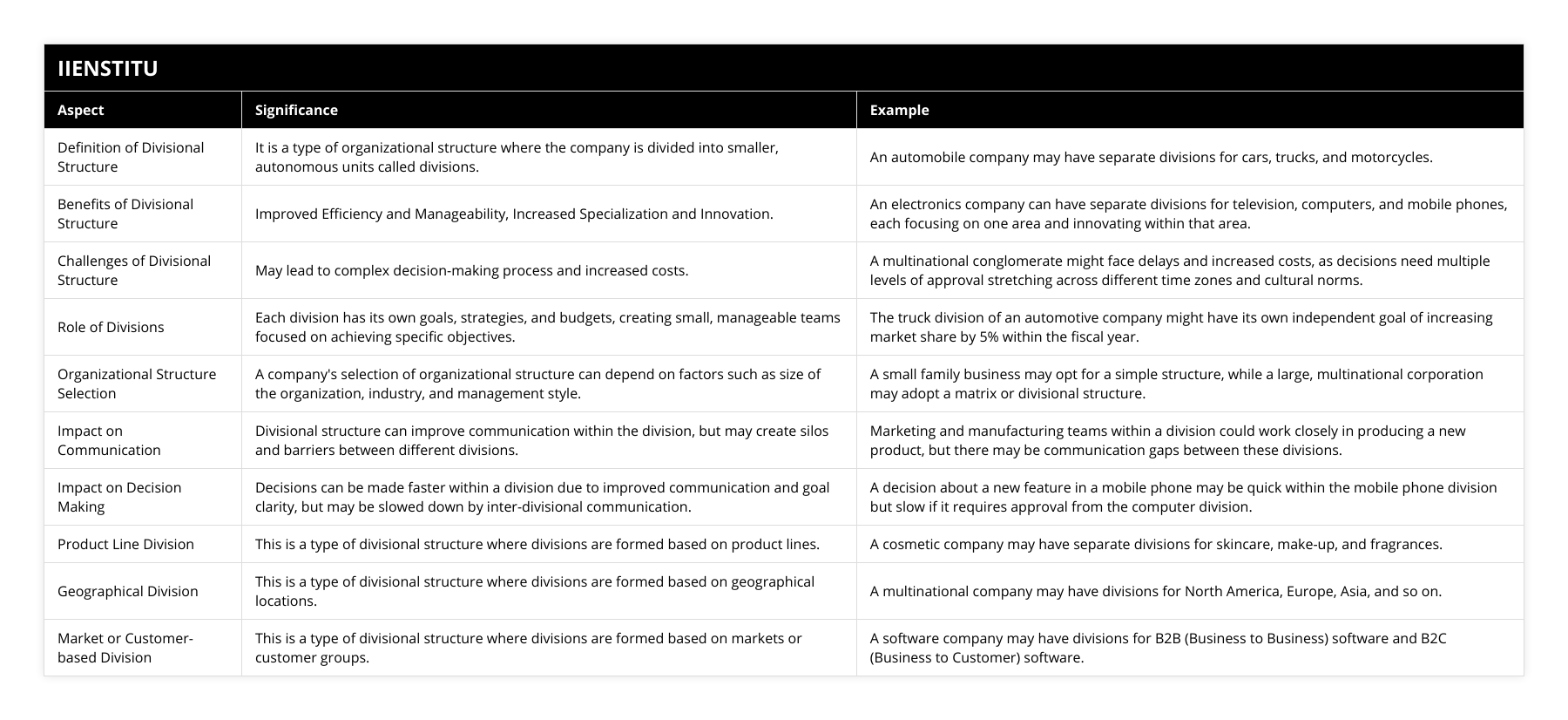
Frequently Asked Questions
What are the benefits of dividing businesses into different niches?
In today's competitive business environment, one of the most effective ways to achieve success is to divide a business into different niches. In doing so, companies can capitalize on their core competencies, identify growth areas and leverage their resources more effectively. This article will discuss three key benefits businesses can enjoy by dividing their operations into different niches.
The first benefit of niche divisions is improved visibility. When a business divides its operations into distinct niches, it allows each slot to stand out and be more easily spotted by potential customers. For example, a business might have a core customer base, but diversifying into new products or companies with different niches can attract a more extensive customer base. This, in turn, boosts profitability and increases customer loyalty.
The second benefit is greater efficiency. Businesses can focus on their core competencies and streamline their operations by segmenting operations into distinct niches. This allows them to do more with less, as each area can be managed independently. In addition, with fewer resources, businesses can shift their focus to tasks more valuable to their goals.
The third benefit is increased scalability. By focusing on specific niches, businesses can better focus their resources on customer needs. As customer demands fluctuate, companies can quickly scale up or down their product offerings to meet the needs of their customers. Furthermore, companies can maximize the potential of their product range through niche marketing, which helps to attract a more engaged consumer base.
By dividing a business into different niches, companies can enjoy many benefits that help them sustain growth and achieve success. Businesses can better adapt to customer demands and increase their bottom line by improving visibility, increasing efficiency, and allowing for scalability.
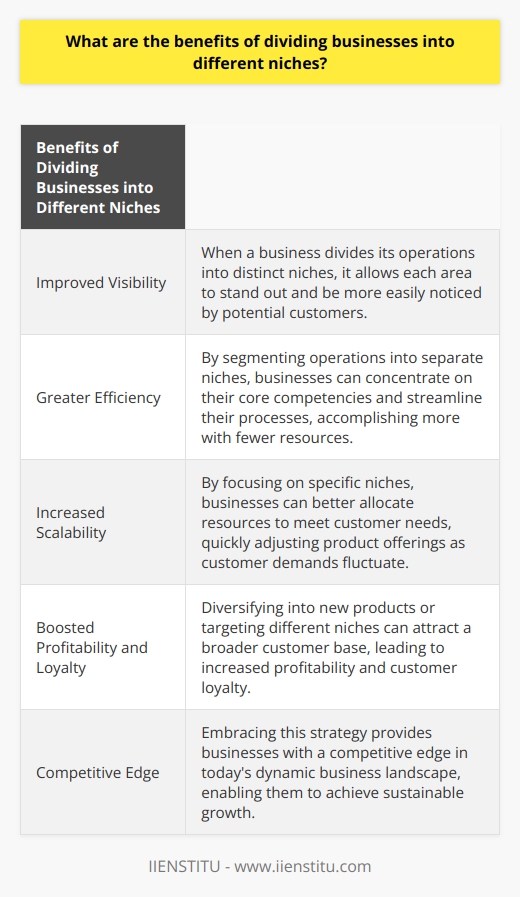
What strategies can corporations use to ensure successful divisional structures?
Divisional structures provide a framework for an organization to pursue multiple lines of business and maximize its resources. This is especially important for large corporations that operate across various markets and industries. As such, corporations need to implement successful strategies for building and maintaining effective divisional structures.
The first strategy is to ensure that the right personnel is placed in the right roles. Individuals must lead the divisions with the requisite skills and experience to manage the tasks and responsibilities associated with the position. In addition, the person conducting the divisions must understand the corporate vision and have the necessary resources to achieve the required goals.
The second strategy is to create a culture of collaboration between the divisions. This can be achieved by fostering an environment where all parties are willing to provide feedback, advice, and suggestions. Furthermore, it is essential to create communication channels between the divisions to ensure everyone is informed about the progress of projects and initiatives. Finally, by promoting collaboration, corporations can assist in creating a unified corporate identity, helping to provide a sense of cohesiveness and direction for employee efforts.
The third strategy is to ensure organizational flexibility. Corporations must build structures that facilitate rapid and continuous adaptation in today's ever-changing business environment. This requires rapidly scaling up or down operational elements or resources as needed. It is, therefore, important that the divisions can swiftly shift to different models and adjust the focus of their activities if necessary.
The fourth strategy is to promote individual accountability. Divisional structures enable the need for personal responsibility and accountability. This may be accomplished by establishing clear performance expectations and providing effective rewards and incentives. In addition, ensuring that each team member is responsible for their assigned tasks' results can help ensure that organizational objectives are met.
Ultimately, corporations must combine the abovementioned strategies to implement divisional structures successfully. Organizations can create an efficient and practical framework for pursuing multiple lines of business by promoting collaboration, flexibility, and individual accountability. With the proper focus and resources, corporations can realize their objectives and maximize the value they derive from their divisional structures.

How can companies use a divisional structure to achieve long-term goals?
Organizations require long-term strategies and strategies for success. A divisional structure is significant tool organizations use to improve efficiency and ensure long-term objectives are achieved. Through a divisional structure, businesses can capitalize on the positive features of departments, decentralize authority and consequently increase overall organizational effectiveness.
The term “divisional structure” refers to how a company structures its operations around specific products and services they offer. Using this framework, organizations create divisions that specialize in developing certain products or services, with each division responsible for its own performance. An advantage of this structure is that it allows each division to focus on a few products or services, which helps streamline operations and maximize productivity.
In addition to streamlining operations, a divisional structure provides numerous other advantages. One of the key benefits is that it allows businesses to decentralize authority and decision-making, which gives each division more autonomy. The decentralizing source also will enable organizations to make decisions that align with their long-term goals and objectives more quickly and effectively since each division is responsible for decision-making.
Using a divisional structure also allows companies to recognize and capitalize on the skills and abilities of their divisions. In addition, each division is given the ability to monitor and analyze its performance, which helps them remain competitive in the market. This structure also allows organizations to quickly and easily adapt their business models to changing market trends and customer needs.
One of the main challenges of a divisional structure is creating a cohesive culture that aligns with the organization’s overall mission and goals. Each division needs to be aware of and understand the needs of the larger organization. When this happens, divisional objectives can be aligned with the organization’s overall long-term strategies, ultimately helping it reach its goals.
When used correctly, divisional structures are an excellent way to maximize productivity and efficiency and ensure that the organization’s long-term objectives are met. Companies can achieve success by giving each division autonomy to make decisions, capitalizing on the skills and abilities of their divisions, and creating a cohesive culture that aligns with the organization’s goals.
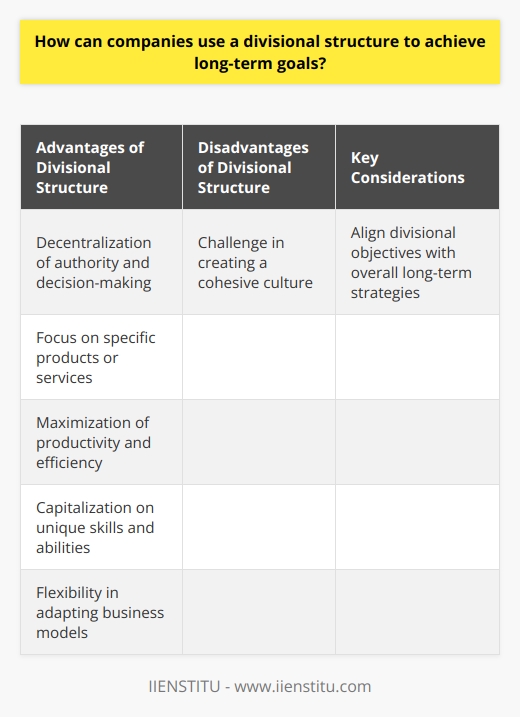
What are the key factors that contribute to the effectiveness of a divisional organizational structure?
Key Factors Contributing to Effectiveness
Division of Labor and Specialization
One key factor in the effectiveness of a divisional organizational structure is the clear division of labor and specialization. This structure allows for each division to focus on a specific product, service or clientele, ensuring that each group of employees possesses the necessary skills and expertise to effectively manage their respective responsibilities.
Accountability and Autonomy
Another contributing factor is the increased accountability and autonomy within each division. By granting decision-making authority to divisional leaders and their teams, the organizational structure fosters a sense of ownership in employees. This empowerment can result in higher job satisfaction and motivation, which in turn can lead to better performance and results.
Efficient Resource Allocation
A divisional structure also enables more efficient allocation of resources. With each division focusing on a specific area, it becomes easier for the organization to track and allocate resources such as finances, personnel, and equipment. This improved resource management can lead to reduced costs, increased productivity, and a more streamlined business operation.
Adaptability and Flexibility
The divisional organizational structure supports adaptability and flexibility, allowing the organization to respond quickly to changing market conditions and customer needs. As each division focuses on its own specialized area, it can modify its approach and strategy independently from other divisions, fostering a nimble and agile business environment.
Facilitating Growth and Expansion
Lastly, a divisional structure can facilitate growth and expansion. As the organization expands its operations or targets new markets, it can create new divisions without significantly disrupting the existing structure. This capability eases the process of scaling and adapting to new business opportunities.
In conclusion, the effectiveness of a divisional organizational structure can be attributed to factors such as clear division of labor and specialization, increased accountability and autonomy, efficient resource allocation, adaptability and flexibility, and facilitation of growth and expansion. By addressing these areas, organizations can ensure that their divisional structure remains effective and well-suited to their business environment.
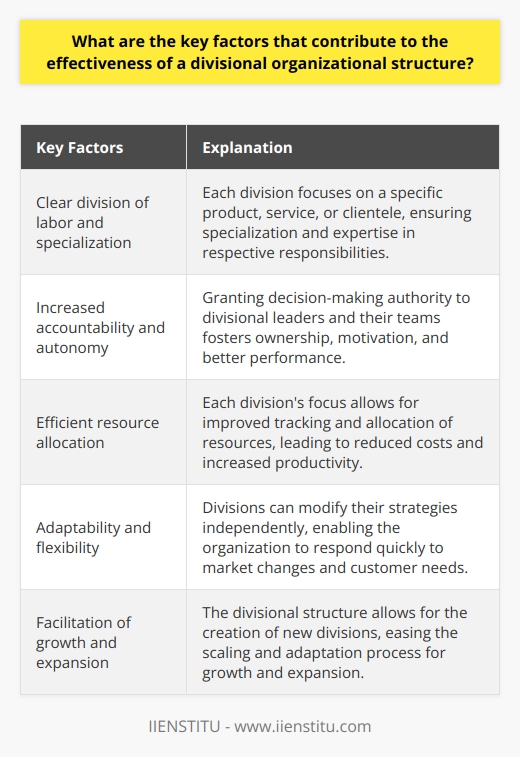
How does a divisional structure impact innovation and collaboration within a company?
Divisional Structure Influence on Innovation
A divisional structure significantly impacts a company's innovation by promoting autonomy and adaptability among different units. With each division focusing on a specific product line or market segment, managers can tailor their approach to achieve the desired outcomes. This flexibility encourages creativity, as divisions have the freedom to experiment with new ideas, thereby fostering innovation within the organization.
Collaboration Enhancement through Divisional Structures
Collaborations between employees and teams are critical to innovation, as they facilitate sharing ideas and information across the organization. A divisional structure can improve collaboration by establishing channels for communication between divisions. Each unit has the opportunity to access resources from other departments and collaborate in ways that may not be possible in a strictly functional structure.
Cross-functional Teams and Divisional Synergy
The establishment of cross-functional teams can also boost innovation and collaboration within a divisional structure. These teams bring together employees from different divisions to work on projects that cut across departmental boundaries. This multidisciplinary approach exposes employees to diverse perspectives and allows them to exchange essential information that can lead to innovative solutions.
Balancing Divisional Autonomy and Organizational Cohesion
However, fostering collaboration in a divisional structure can be challenging due to potential conflicts between divisions. Managers must balance autonomy with the need for organizational cohesion to minimize competition and maintain collaborative practices. Ensuring open communication, clarifying goals, and promoting synergistic opportunities can help mitigate these challenges and enhance collaboration within the organization.
Leveraging Technology for Effective Coordination
Moreover, companies can leverage technological advancements, such as collaboration tools, video conferencing, and project management platforms, for effective coordination between divisions. These tools facilitate the exchange of ideas and data, helping employees stay connected and collaborate effectively, regardless of their geographical location or divisional affiliation.
Conclusion
In summary, a divisional structure can significantly impact innovation and collaboration within a company by fostering autonomy, enhancing cross-functional teamwork, and establishing channels for communication across the organization. Balancing divisional autonomy, leveraging technology, and promoting synergy among divisions can lead to a thriving, innovative corporate culture that drives organizational success.
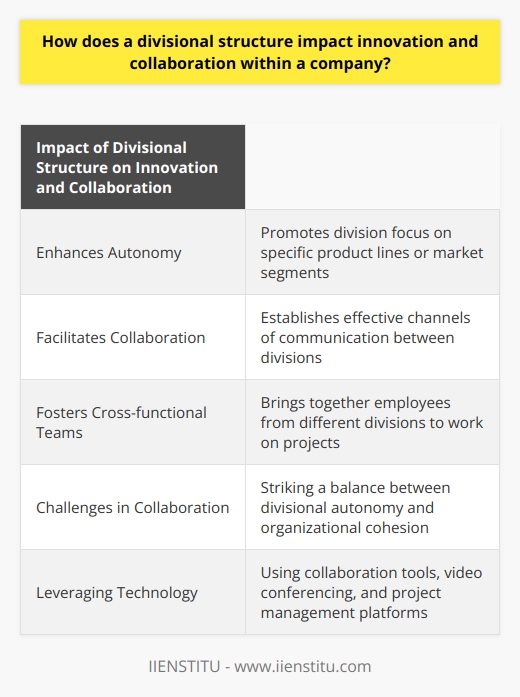
In what industries or contexts is a divisional organizational structure especially beneficial or detrimental?
Benefits of Divisional Structure in Specific Industries
A divisional organizational structure is particularly beneficial in large, diversified companies operating in distinct industries or markets. This structure allows organizations to adapt quickly to market changes and streamline decision-making processes. In the automotive industry, for example, a divisional structure enables manufacturers to focus on designing, producing, and marketing vehicles tailored to specific customer segments. Airlines can also benefit from this approach, managing their regional, national, and international operations as separate divisions.
Detriments in Certain Contexts
However, a divisional structure can be detrimental in industries or contexts where collaboration, knowledge sharing, and resource optimization are critical for success. In research and development (R&D) environments, this organizational design may hinder the free flow of information and ideas among scientists and engineers, limiting innovation and cross-functional learning. High-tech and pharmaceutical sectors, which rely heavily on R&D, can experience these negative effects. Divisional structures can also prove problematic for companies relying on economies of scale to achieve cost efficiencies, as duplication of functions and resources across divisions may increase operational costs.
Ideal for Market Responsiveness
One of the main advantages of a divisional structure is its ability to enhance market responsiveness. By focusing on specific market segments or products, divisions within large, diversified organizations can effectively tailor their strategies, operations, and offerings to customer needs. This heightened responsiveness ultimately strengthens the company's competitive position in various markets, allowing for better overall performance.
May Increase Costs and Complexity
However, the divisional approach can lead to increased organizational complexity and higher costs of operation if not appropriately managed. As divisions may have their administrative and support functions, this can result in redundancy and a loss of potential cost synergies. Additionally, by grouping employees with similar skills and knowledge within specific divisions, a divisional structure may hinder cross-functional collaboration and learning, negatively affecting the organization's ability to innovate and grow.
Empowerment of Division Managers
A divisional organizational structure promotes autonomy and empowers division managers to operate as independent business units. This autonomy leads to faster decision-making and increased accountability, as the success or failure of each division rests squarely on the shoulders of its management. Divisional leaders are, therefore, highly motivated to excel in managing their respective businesses, contributing to the overall success of the organization.
In conclusion, a divisional organizational structure is especially beneficial for large, diversified organizations operating in distinct industries or markets, while it may be detrimental in environments where collaboration, knowledge sharing, and resource minimization are critical for success. Adopting a divisional structure can enhance market responsiveness, empower division managers, and foster growth. However, companies must weigh these benefits against potential drawbacks such as increased complexity, operational costs, and limitations to cross-functional collaboration.
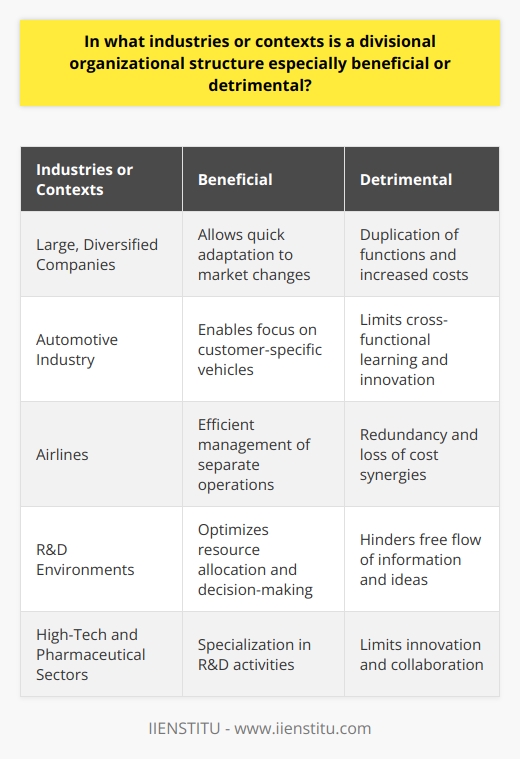
What is divisional structure in corporate strategy?
Divisional Structure: Definition and Purpose
Divisional structure in corporate strategy refers to an organizational design where a company's operations are segmented into divisions, each of which serves a specific market, product line, or geographical area, and operates independently under the guidance of a separate management team. This approach enhances the overall performance and productivity of the separate divisions, as it allows them to focus on particular objectives suited to their markets, resources, and expertise.
Advantages of Divisional Structure
One main advantage of divisional structure is the clear delineation of responsibilities and authorities, as managers and employees within each division can make decisions directly related to their specific field. This localized decision-making promotes higher agility and faster responses to market demands, competitive threats, and other changes in the business environment.
Additionally, a divisional structure encourages greater accountability across an organization, as the performance of each division can be assessed independently. This can stimulate healthy competition among divisions, which can subsequently drive overall growth and innovation for the parent company.
Disadvantages of Divisional Structure
Despite these advantages, divisional structures also have drawbacks. One significant issue is the potential for competition between divisions to lead to clashes of priorities, resources, and managerial decisions. Overlapping responsibilities and duplication of efforts can reduce efficiency and increase operating costs. Furthermore, the separation of divisions may hinder communication, data sharing, and coordination of strategic initiatives between divisions and the corporate level, and may slow down decision-making processes.
Appropriate Use of Divisional Structure
A divisional structure is particularly suitable for large, diversified companies with diverse product offerings or those operating in various geographical locations. As the company grows and explores new markets and customer segments, it becomes increasingly essential to have distinct divisions specializing in specific areas. This structure allows each division to focus on its unique goals, while contributing to the company's overall strategic objectives.
Conclusion
In conclusion, the divisional structure in corporate strategy is a beneficial organizational design that can enhance decision-making, accountability, and market responsiveness. With careful management and effective communication between divisions and the corporate level, this structure can create an environment for growth, innovation, and success for diverse and multifaceted organizations.
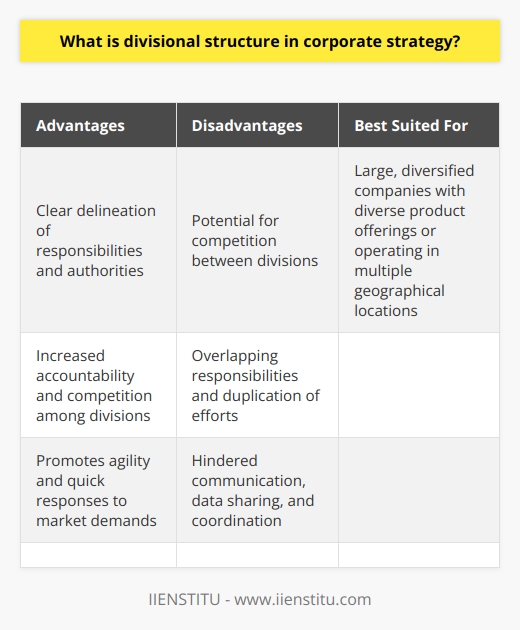
How can divisional structure help business to grow?
Divisional Structure for Business Growth
Organizational Efficiency
The implementation of a divisional structure can significantly increase a business's efficiency. By dividing the company into multiple operating units, management can more effectively delegate responsibilities and assign specialized managers to each unit. This not only allows for greater focus on specific projects and goals, but also permits better allocation of resources within the organization.
Enhanced Decision-making
One of the most critical aspects of running a successful business is making informed decisions. Divisional structures promote faster and more accurate decision-making since each division is responsible for its operations. This empowers managers to devise strategies tailored to their units based on their knowledge and experience. Furthermore, decisions can be made rapidly without navigating through cumbersome bureaucratic channels.
Focused Innovation and Collaboration
In a divisional structure, employees can more readily collaborate, fostering an innovative and creative work environment. As employees within a division share common objectives and expertise, they are more likely to generate novel ideas and approaches to problem-solving. This focused innovation can lead to the discovery of new market opportunities, new products, and improved services, ultimately contributing to the overall growth of the business.
Flexible Adaptation to Market Changes
Businesses with divisional structures are better positioned to adapt to changes in the market. When a particular division encounters declining revenues or increased competition, the organization can quickly address these challenges without adversely affecting other divisions. This flexibility allows the business to respond proactively to emerging trends and market conditions while preserving its overall stability.
Reduced Risks
Finally, a divisional structure allows business to mitigate risks more effectively. If one division performs poorly, its impact on the overall company is less severe compared to a centralized, hierarchical structure. By distributing risk across several divisions, companies can implement more aggressive growth strategies within each division, knowing the potential consequences will be limited.
In conclusion, the divisional structure offers businesses several advantages that contribute to sustained growth. By enhancing organizational efficiency, promoting rapid decision-making, fostering focused innovation, enabling flexible adaptation to market changes, and reducing risks, divisional structures equip businesses with the necessary tools to navigate an increasingly competitive and dynamic market.
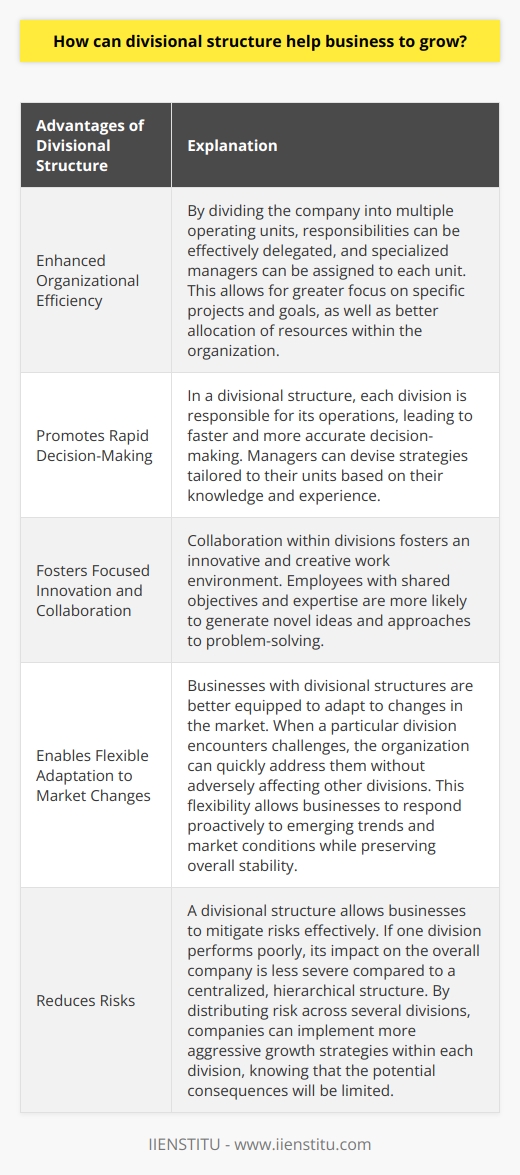
What are the strengths of divisional structure?
Overview of Divisional Structure Strengths
Enhanced Focus on Products and Services
One of the primary strengths of divisional structure is the enhanced focus on specific products or services. By organizing a company into distinct divisions based on products or services, each group can better concentrate on the development, marketing, and support of their specific offerings. This specialized focus improves both the efficiency and effectiveness of the divisions, leading to more satisfied customers and increased profitability.
Increased Adaptability and Flexibility
Divisional structures also offer increased adaptability and flexibility, particularly when compared to other organizational structures like functional or matrix designs. Each division operates semi-autonomously with a streamlined decision-making process, allowing them to respond rapidly to changing market conditions, customer needs, or even regulatory challenges. This heightened agility enables faster decision-making and implementation and provides a competitive advantage in fast-paced, rapidly evolving industries.
Improved Managerial Development and Accountability
Another key strength of divisional structures is the opportunities they present for managerial development and increased accountability. By assigning a manager to each division, organizations can groom future leaders and develop their skills in budgeting, hiring, and managing resources. At the same time, these managers are held accountable for their division's performance, driving them to pursue excellence and achieve desired results. This clear chain of responsibility leads to better overall business performance.
Fostering Innovation and Creativity
Divisional structures often foster innovation and creativity, as each group is encouraged to act entrepreneurially and develop new ideas. This structure allows teams to explore new approaches and examine problems from unique perspectives, facilitating the development of innovative solutions. Additionally, by facilitating collaboration across divisions, companies can benefit from cross-functional synergies that result in improved product offerings and more effective marketing strategies.
Reduced Organizational Complexity
Finally, one of the more practical strengths of divisional structures is the reduction in overall organizational complexity. By grouping related functions together, companies can streamline communication and foster more effective collaboration within divisions. This structure eliminates the need for complicated communication channels between separate functional units, leading to increased efficiency and a more organized, manageable organization overall.
In conclusion, divisional structures provide various strengths that contribute to improved business performance. By promoting an enhanced focus on products or services, adaptability, managerial development, innovation, and reduced complexity, companies can achieve greater success in their respective industries, foster a culture of innovation and growth, and remain agile in ever-changing business environments.
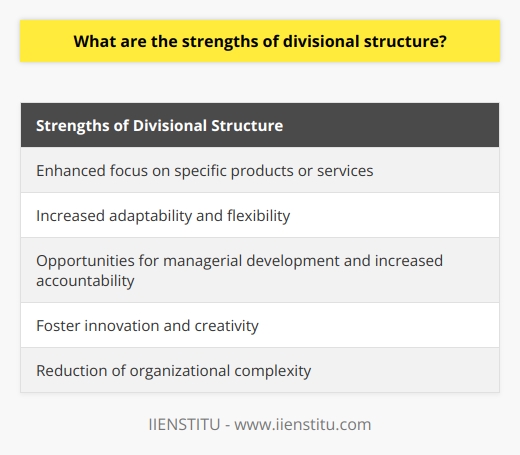
What are the key characteristics of a divisional corporate structure and how do they contribute to organizational effectiveness?
Key Characteristics of Divisional Structure
A divisional corporate structure is characterized by semi-autonomous business units, often referred to as divisions, which are responsible for their own products, services, and markets. This structure allows organizations to achieve a higher level of flexibility and responsiveness to changing market conditions while simultaneously fostering a culture of accountability and ownership among employees.
Self-Contained Divisions
One key characteristic of a divisional corporate structure is the presence of self-contained divisions. These divisions operate independently, with their own management, resources, and decision-making processes. As a result, each division can focus on its specific market segment, tailoring its products and services to meet the unique needs of its customers. This targeted approach ultimately contributes to organizational effectiveness by enabling divisions to pursue their individual goals while remaining aligned with the broader organizational strategy.
Specialized Expertise
Another critical aspect of a divisional structure is the fact that it facilitates the development of specialized expertise within each division. By assigning employees and resources to specific business units, organizations can ensure that their teams possess the necessary knowledge and skills to excel in their respective domains. This specialization allows for greater efficiency in decision-making and problem-solving, as well as improved performance in terms of product development and customer service.
Enhanced Coordination and Communication
Furthermore, divisional structures promote enhanced coordination and communication among different business units. Divisions are encouraged to collaborate and share information, leading to increased synergy and innovation across the organization. By streamlining communication channels and fostering a spirit of cooperation, a divisional structure ultimately contributes to the organization's overall success.
Decentralized Decision Making
A divisional corporate structure is also characterized by decentralized decision making. This feature empowers divisions to make timely and informed decisions, resulting in more agile and responsive actions to address the demands of their respective markets. By placing decision-making authority closer to the front lines, organizations with a divisional structure can more effectively recognize and capitalize on emerging opportunities.
In summary, a divisional corporate structure offers several key characteristics that contribute to organizational effectiveness. The creation of self-contained divisions fosters specialized expertise, enhanced coordination and communication, and decentralized decision making, all of which enable organizations to better adapt and respond to the dynamic business environment. As a result, adopting a divisional structure can be a valuable strategy for organizations seeking to improve their overall performance and achieve their strategic objectives.
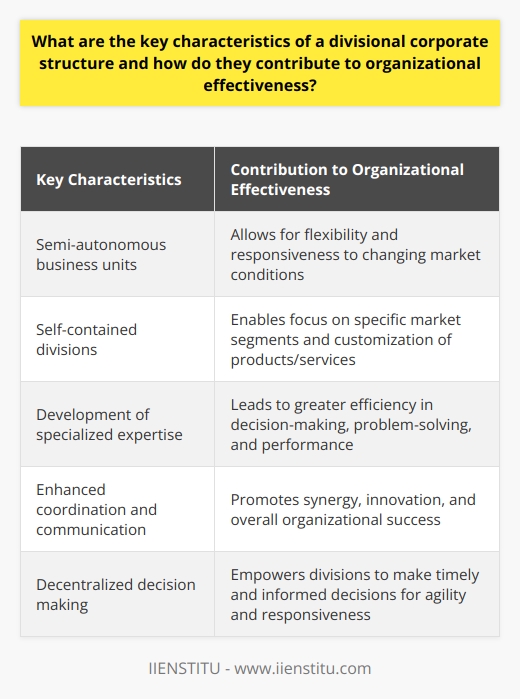
How does a divisional structure impact the allocation of resources and decision-making within an organization?
Divisional Structure and Resource Allocation
A divisional structure, characterized by separate business units operating under a centralized management, influences the allocation of resources within an organization by decentralizing decision-making processes. Each division is responsible for its resources, aligning them with its unique objectives and requirements. Consequently, this leads to a more efficient allocation of resources tailored to the specific needs of each division and the organization overall.
Impact on Decision-Making
The decentralized nature of a divisional structure allows for quicker and more adaptive decision-making processes. Since individual divisions have more autonomy, they possess the flexibility to make decisions that best suit their specific circumstances. This enhances overall organizational efficiency as each division can address any challenges or opportunities it encounters without waiting for approval from the centralized management. However, it may also result in a lack of collaboration between divisions, potentially leading to fragmented decision-making.
Responsiveness and Adaptability
The ability of divisions to make independent decisions fosters a more responsive and adaptable organizational environment. Each division can easily react to market changes, adjust strategies, and adapt to new challenges more effectively than a centrally managed structure where decisions may have to go through various hierarchical levels. This increased responsiveness can lead to better overall performance and competitiveness in the market.
Coordination between Divisions
While a divisional structure provides flexibility in resource allocation and decision-making, it also necessitates robust coordination mechanisms between divisions. To avoid contradictory decisions, organizations must establish clear communication channels and establish shared objectives that align with the overall organizational goals. This ensures that divisions work in synergy, optimizing the use of resources and streamlining decision-making processes.
In conclusion, a divisional structure significantly impacts the allocation of resources and decision-making within an organization by decentralizing and delegating responsibilities to individual divisions. This structure promotes efficiency, adaptability, and responsiveness while also requiring strong coordination efforts to ensure consistent decision-making across divisions. Organizations that successfully maintain this balance can reap the benefits of a more agile and efficient decision-making process, tailored to the specific needs of each division.
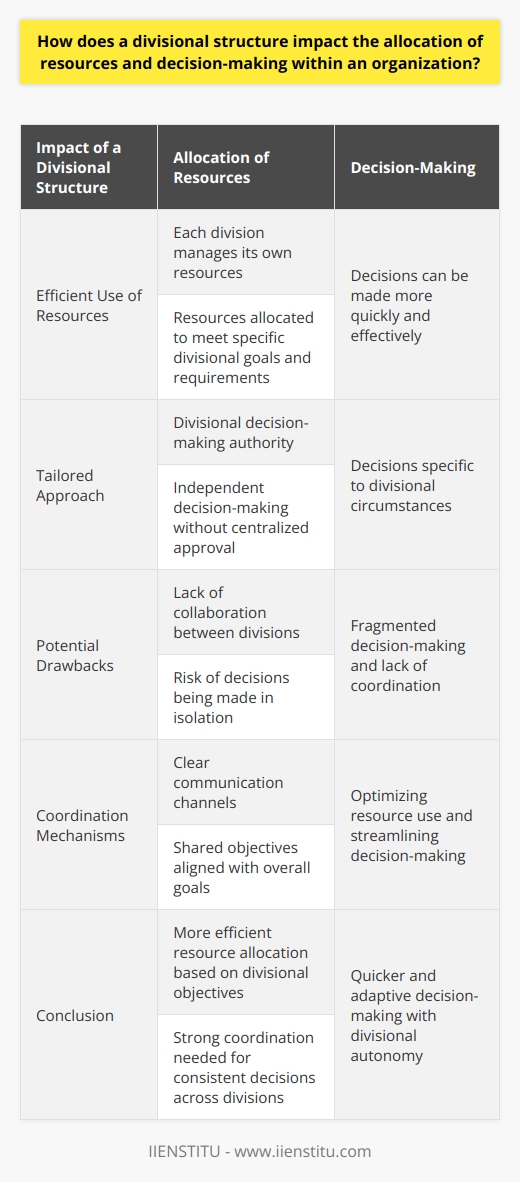
What challenges might an organization face when implementing a divisional structure, and how can these challenges be addressed?
Challenges of Implementing Divisional Structure
Organizational complexity
The implementation of a divisional structure can create organizational complexity. Large companies with multiple divisions can struggle to coordinate and streamline operations across different divisions. To address this challenge, clear communication channels should be established, and effective management layers must be put into place to ensure that each division operates efficiently and aligns with the overall corporate strategy.
Lack of control and coordination
The establishment of individual divisions within the organization can lead to a lack of control and coordination at the top level. A solution to this challenge is to implement a strong central management to supervise each division and ensure that its objectives align with those of the organization as a whole. Additionally, a well-designed system of reporting and information flow can help upper management monitor performance and make informed decisions.
Unequal resource allocation
Divisional structures may cause unequal allocation of resources. Some divisions might receive more funds and focus than others, possibly leading to jealousy and internal rivalry. To overcome this issue, organizations must establish a fair and transparent process that allocates resources based on clear criteria, such as market potential, growth prospects, or strategic importance. This ensures that divisions receive the resources they require and maintain a fair competitive environment.
Duplication of efforts
In a divisional structure, duplication of efforts can lead to inefficiencies and increased costs when departments perform overlapping functions. To address this issue, organizations should adopt shared services and practices, such as procurement or human resources, across divisions to enable cost reduction and a more streamlined management structure.
Cultural differences and resistance to change
Organizations may encounter resistance from employees during the implementation of a divisional structure due to cultural differences and ingrained functional mindsets. To mitigate this challenge, the company should invest time and resources into educating its employees about the benefits of divisional structures and the organization's vision for future growth. A strong change management plan and effective communication are key to creating a supportive environment.
In summary, implementing a divisional structure poses several challenges that organizations must navigate, such as organizational complexity, lack of control and coordination, unequal resource allocation, duplication of efforts, and resistance to change. To overcome these challenges, organizations must establish effective communication channels, central management, shared services, and a strong change management plan, ultimately enabling them to streamline operations and achieve their growth objectives.

What are the key elements of a divisional organizational structure that drive business growth?
Divisional Organizations Promote Autonomy
A divisional organizational structure is one key growth driver, primarily due to autonomous elements. These entities operate similar to separate companies within an organization, leading to overall business growth.
Decentralization Fosters Responsibility
This structure promotes a decentralized setup where each division has its own decision-making authority. Here, leadership does not rest with one central figure. Instead, multiple division heads shoulder responsibility. They make critical decisions bolstering business growth.
Role of Divisional Heads in Growth
These division heads play crucial roles in driving growth. Their actions directly influence the performance of their respective divisions. Therefore, their ability to steer their divisions effectively can significantly contribute to business expansion.
Emphasis on Specialization
One key divisional structure aspect is the emphasis on specialization. Each division focuses on a distinct product or service, adopting unique strategies for its development and marketing. This element encourages innovation, crucial for continuous business growth.
Interdivisional Cooperation
Interdivisional cooperation is another vital divisional structure feature. Here, decisions taken by one division impact others. This interplay mandates collaboration, necessary for effective decision-making and sustained growth.
Divisional Structures Encourage Competition
Moreover, competition among divisions stimulates business growth. Each division strives to outperform others, leading to an increase in overall organizational growth.
Financial Accountability in Divisional Structure
Finally, each division within this setup is individually responsible for its financial performance. Consequently, fostering financial accountability could guide business expansions.
In summary, divisional organizational structures harness the power of decentralization, specialization, interdivisional cooperation, competition, and financial accountability to drive business growth.
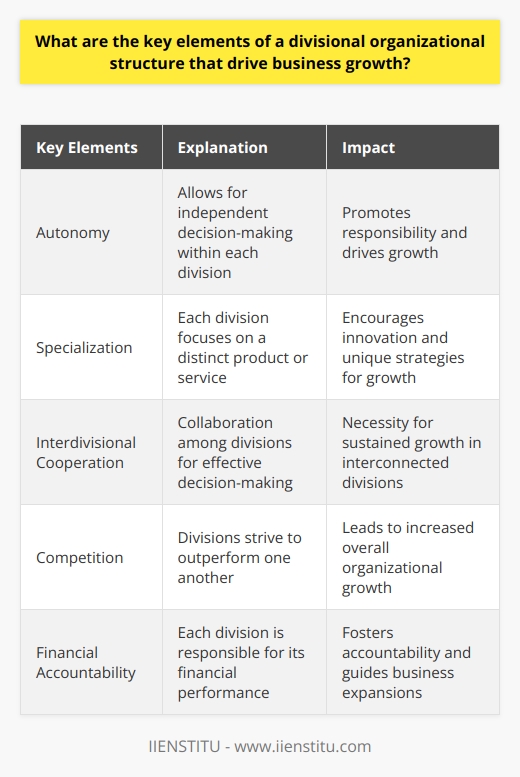
How does a divisional corporate structure foster increased adaptability and responsiveness in a dynamic market environment?
Enhanced Adaptability
A divisional corporate structure promotes adaptability by empowering different divisions to react swiftly to market changes. This structure allows them to modify their strategies without needing approval from the central office. This ensures a swift response to unforeseen challenges.
Micro-Management Proficiency
Each division within a corporation operates like a separate company by managing its own operations. This allows for undiluted focus and nurtures the proficiency required for micro-management. Consequently, businesses can adapt quickly to counteract any specific industry challenges.
Market-Specific Adjustments
Since each division caters to a unique market segment, it increases their ability to understand and respond to marking needs. As each segment has its own unique behaviours and trends, a divisional structure facilitates tailored strategies ensuring responsiveness to specific customer needs.
Decision-Making Efficiency
A decentralized setup enhances decision-making efficiency. Various divisions have in-depth knowledge of their respective markets. This insight promotes them to make astute decisions swiftly, which is critical in a dynamic market.
Reduced Bureaucracy
Reducing the size of the bureaucratic chain expedites decision-making processes. In a divisional structure, sectors are able to take swift actions in response to market changes, without needing to navigate through layers of management.
Accountability
A divisional corporate structure encourages accountability. Each division has its own set of goals and targets and it holds its leaders accountable. This fosters proactive leadership, resulting in improved response and adaptability to market environments.
Thus, a divisional corporate structure fosters an increased level of adaptability and responsiveness distinct to dynamic market environments. By empowering sectors to take responsibility, make decisions and drive strategies, businesses can better respond to the evolving climates and challenges of their markets.
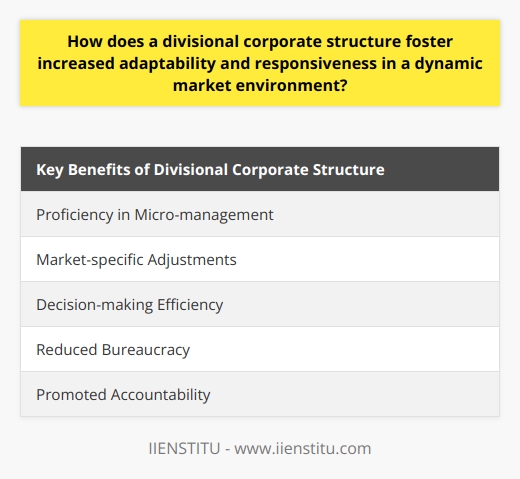
Can you provide a real-world example of a company that has successfully implemented a divisional organizational structure and the resulting outcomes?
Subheading: Success of the Divisional Structure in Samsung
One compelling example of a company that employs a divisional organizational structure effectively is Samsung. This South Korean multinational company is mainly segmented into three main divisions: Consumer Electronics (CE), Information Technology & Mobile Communications (IM), and Device Solutions (DS).
Subheading: Strength in Diversity and Specialization
Each division specializes in a new business sector, driving the company's robust portfolio. The CE division deals with TVs, monitors, refrigerators, washing machines and other such products. In contrast, the IM division focuses on mobile phone manufacturing, including the acclaimed Galaxy series. Meanwhile, the DS division takes charge of the semiconductor, memory, and LED solutions for various purposes.
Subheading: Possibility of Rapid Adaptation
This structure allows Samsung to adapt rapidly to market changes, permitting each division to act independently and make decisions quickly without substantial bureaucratic interference. For example, when the mobile phone market started shifting towards smartphones, the IM division at Samsung was able to respond faster and produce the Galaxy series, which quickly became one of its biggest income channels.
Subheading: Advantages of Skin in the Game
This divisional structure also encourages healthy competition within the company, with each division attempting to outperform the others. This internal rivalry can inspire creativity and drive, propelling the company to innovatively address various market niches.
Subheading: Resulting Outcomes
Consequently, the adoption of this divisional structure has led Samsung to remarkable success. It has propelled the organization towards being a leading global brand, with a presence in many diverse fields. Ultimately, the divisional organizational structure at Samsung demonstrates the immense potential for business growth and adaptability.
